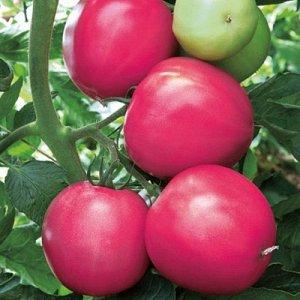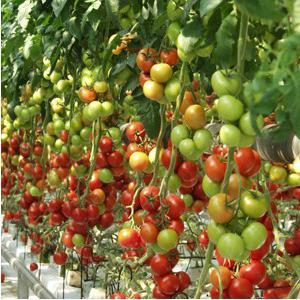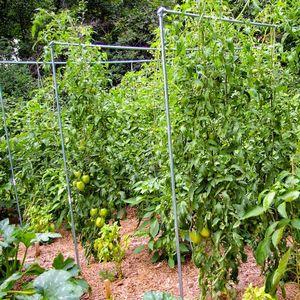What vegetable growers say about the Kalinka-Malinka tomato
Almost everyone knows the song “Kalinka-Malinka” in Russia, and throughout the world. Probably, this song really resonated with tomato breeders and inspired them to name a new one. tomato variety "Kalinka-raspberry."
Let's figure out why this variety is good, what are the features of its cultivation, and how experienced tomato growers speak about it.
Characteristics and description of the tomato variety “Kalinka-Malinka”
This variety of tomatoes appeared relatively recently, but has already become a favorite among gardeners. This is a mid-season super-determinate tomato variety. It does not have F1 generation hybrids.
Suitable for growing:
- in open (unprotected) ground;
- under film (spunbond or other material);
- in the greenhouse.
This is what ripe tomatoes look like in the photo:

“Kalinka-Malinka” is a standard variety of tomatoes. The plant grows small, ultra-compact and has practically no branches.
Let's consider the main characteristics of the variety:
| Index | Description/meaning |
| Tomato ripening period | 110-115 days from the moment the seeds are planted in the soil |
| Bush height | 25-30 cm |
| Fruit shape | Round |
| Dry matter | Contained in tomatoes of this variety in large quantities. Tomatoes are not watery |
| Weight and size of tomatoes | One tomato reaches an average diameter of 4 cm and weighs about 50 g |
| Number of seeds | There are few seeds in the fruits. Located inside the tomato in two or three segmental nests |
| Productivity | From 2.5 to 4 kg per square meter (depending on planting density) |
| Keeping quality of fruits | Tomatoes of this variety have good keeping quality. Fruits are stored for a long time |
| What is it used for? | Consumed fresh (both whole and in salads), frozen, dried and canned |
In terms of care, the variety is unpretentious. In Russia, tomatoes bear fruit without a greenhouse, even in the conditions of Siberia and the Urals.
Advantages and disadvantages of the variety
Let's review what varieties there are advantages and disadvantages:
| Positive points | Negative points |
| Suitable for any landing site - both open and closed ground | Poorly developed root system, located mainly in the top layer of soil |
| Tomatoes keep well | Small fruits (from 50 g) |
| Plants do not require much attention and are easy to care for | Not an early ripening variety |
| The variety is quite resistant to diseases |
Attention! The fact that plants of this variety have a poorly developed root system can at the same time be considered as an advantage. Thanks to this, you can grow a larger number of bushes in a small area. Even if Kalinka-Malinka tomatoes are planted closer to each other, the yield will not suffer.
How to grow
It is best to grow in seedlings. Before planting, the seeds are treated with any growth stimulant (for example, Epin).
Seeds germinate well at temperatures from 23 to 25 degrees. They are usually sown in March, 60 days before planting in the main place. Caring for seedlings is simple: watering with settled water, loosening, picking.
When planting seedlings in the main place, use the following plant placement scheme:
- from 40 cm between rows;
- from 25-30 cm between tomatoes in a row.
Plants are planted up to 6-8 pcs. per one square meter. The bushes are low, it is convenient to grow them on the balcony in containers or in tubs on the site. If grown in open ground, when it gets colder they can easily be covered with spunbond or film.
10-12 days after planting, the plant stems are earthed up.It is better to mulch the surface of the ground (cover it with mowed grass).
There is no need to pin this variety of tomatoes (remove shoots between the stem and leaves). This feature makes Kalinka-Malinka a very easy variety to cultivate.
Tomatoes are watered regularly, not necessarily abundantly. This simple rule will help the bush grow compact.
Prevention of diseases and pests
Kalinka-raspberry exhibits high resistance to diseases. It is rarely affected by late blight.
If there are pests, to prevent infection of tomatoes, “fragrant” spraying is carried out. The pungent odor will repel aphids and caterpillars.
Examples of compositions:
- Garlic tincture. It is prepared by infusing 250 g of garlic in four to five liters of water for several hours. The solution is sprayed onto tomato leaves.
- Tobacco solution. It is prepared from five liters of hot water and 200 g of chopped tobacco. Leave for 24 hours. After filtering, the bushes are sprayed.
If folk remedies are powerless and infection still occurs, insecticides such as Aktarin or Karbofos will help. Dosage - according to the manufacturer's instructions.
Important! Observe safety precautions when working with insecticides: when spraying the solution on tomatoes, use a respirator and protective gloves.
Reviews from gardeners
Experienced gardeners recommend using the variety for open ground, considering it inappropriate to take up space in the greenhouse for such small tomato bushes.
Many note that the variety is excellent for growing for sale. Thanks to its resistance to diseases tomatoes of the Kalinka-Malinka variety give a good harvest. Moreover, the fruits retain their presentation for a long time.
Many summer residents who preferred this variety were pleased with the minimal care that the bushes require. And lovers of homemade preparations leave reviews about the excellent quality of the fruits. The meatiness of such tomatoes is ideal for pickling and pickling. The fruits have little water, so it is very convenient to dry them.
Let's sum it up
The tomato variety “Kalinka-Malinka” does not require much care, which is why it is loved by Russian tomato growers. The basic rule of growing is regular watering. There is no need to tie or pin. The bushes are compact, low, and practically do not branch. They can be planted more densely. Even from a small garden bed a significant harvest is harvested.